Explore Gaborone - Botswana Travel, Africa
Located in the southern part of Botswana, Gaborone is a vibrant capital city known for its mix of modernity and cultural depth. As the nation's economic hub, Gaborone is a melting pot where tradition and progress intertwine. This rapidly growing city offers a unique blend of urban experiences, nature reserves, and cultural landmarks, making it an attractive destination for both adventurers and culture enthusiasts.
Population: Approximately 250,000 in 2022.
Economy: Gaborone's economy is diverse, driven by sectors like finance, commerce, and government services. The city also supports manufacturing and tourism, contributing to steady economic growth.
Landmarks: Famous for the Gaborone Game Reserve, Three Dikgosi Monument, and Mokolodi Nature Reserve.
Botswana
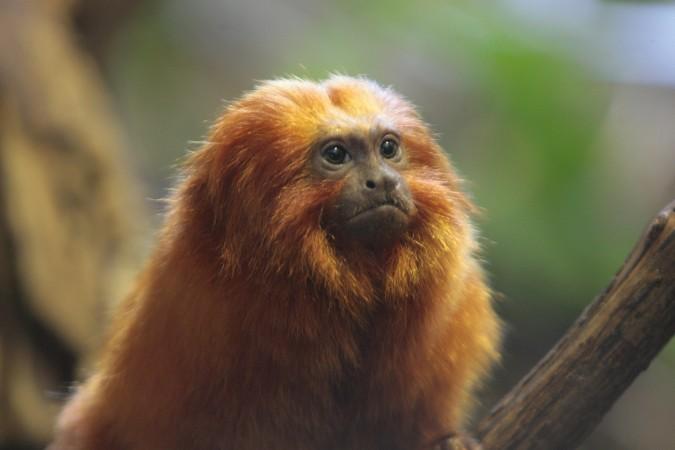
Overview of Gaborone
History & Cultural Influence
The roots of Gaborone are deeply tied to the history of Botswana and the Tswana people. Named after Chief Kgosi Gaborone, the city began as a small colonial town in the late 19th century. Following Botswana’s independence in 1966, Gaborone was designated as the capital and a symbol of national pride and development. Visitors to Gaborone can still witness the strong influence of Tswana traditions and colonial architecture. The fusion of traditional Tswana values with modern influences is visible in both the cultural and physical landscape of the city, making it a fascinating destination for those interested in learning more about Botswana’s past and present.
Interaction with the Locals
Gaborone's population is at 250,000, making it one of Botswana's fastest-growing cities. The bulk of the population is Tswana, the country's largest ethnic group. The city is also home to a diverse mix of ethnicities and expatriates, creating a vibrant, multicultural atmosphere. English and Setswana are widely spoken, with locals known for their hospitality and warmth, making visitors feel welcome. The blend of traditional and modern influences in Gaborone is reflected in the daily life of its citizens.
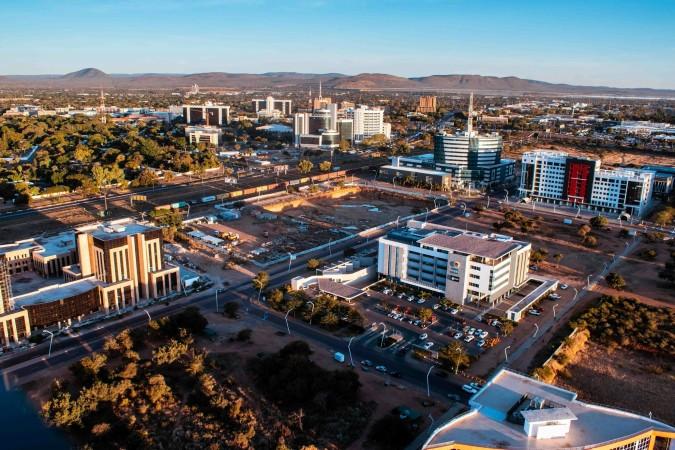
Central Business District in Gaborone, Botswana - © Justice Hubane
Top Attractions in Gaborone
Gaborone Game Reserve
The Gaborone Game Reserve, located just minutes from the city center, is one of Botswana's most easily accessible wildlife areas. It offers visitors the chance to see zebras, warthogs, ostriches, and various bird species without leaving the urban area. Whether you're a wildlife enthusiast or looking for a peaceful retreat, the game reserve provides a quiet escape where nature and city life meet.
Three Dikgosi Monument
A symbol of Botswana's proud journey to independence, the Three Dikgosi Monument stands as a tribute to the three chiefs who traveled to Britain to negotiate the country's freedom from colonial rule. This imposing monument is not just a historical landmark, but also a place to learn more about the leadership and vision that shaped modern Botswana.
Kgale Hill
For adventurers and nature lovers, Kgale Hill offers one of the best hiking experiences in Gaborone. Kgale Hill, often known as "The Sleeping Giant," provides hikers with breathtaking panoramic views of the city and surrounding countryside. It’s the perfect spot to watch the sunset or to capture breathtaking photos of Gaborone from above.
Mokolodi Nature Reserve
Located just outside the city, the Mokolodi Nature Reserve provides a more expansive wildlife experience. This reserve is home to rhinos, giraffes, antelopes, and many other species, making it an ideal destination for guided safaris. Visitors can also enjoy scenic picnic spots, birdwatching, and even take part in conservation programs to learn more about protecting Botswana's wildlife.
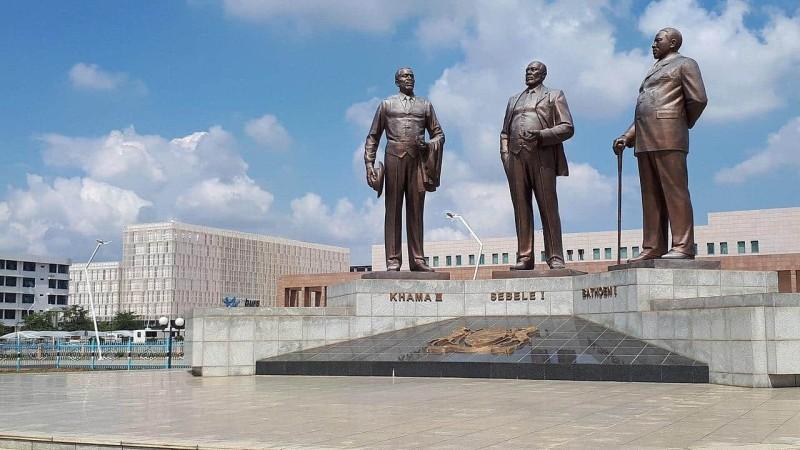
The Three Dikgosi Monument - © Wikipedia
Must-Try Dishes in Gaborone
Exploring Gaborone’s culinary tradition is a delightful experience, offering a range of local dishes that reflect the rich flavors and traditions of Botswana.
- Seswaa: A typical Botswana meal composed of slow-cooked beef, commonly served with onions and spices. Seswaa is typically served with a side of pap (a maize porridge) or bogobe (a fermented maize dish), making it a hearty and flavorful meal.
- Bogobe: A fermented maize porridge that has a tangy flavor and a slightly sour taste. Bogobe can be enjoyed with meat dishes, especially with stews like seswaa, or as a breakfast item.
- Kota: A popular street food, kota is a type of stuffed sandwich made from a quartered loaf of bread filled with a variety of ingredients such as meats, cheeses, and sauces. It’s a flavorful and satisfying snack that showcases local culinary creativity.
- Tswii: A dish made from groundnuts (peanuts) cooked into a thick, savory sauce. Tswii is often served with rice or pap and offers a rich, nutty flavor that compliments other traditional dishes.
- Biltong: A form of dried, cured meat similar to jerky, biltong is a popular snack throughout Southern Africa. It is typically made from beef and seasoned with a blend of spices, offering a savory and protein-rich treat.
- Boerewors: A type of traditional South African sausage made from a mixture of beef, pork, and spices. Boerewors is grilled or barbecued and enjoyed as a flavorful addition to various meals, including pap or salads.

Boerewors - © Delicious
Festivals & Local Celebrations
Gaborone is a city that loves to celebrate its culture and heritage, and visitors can experience this vibrancy through its festivals and events.
Botswana Independence Day
The most significant celebration in Gaborone is Botswana Independence Day, which marks the country’s independence from British rule in 1966. The day is filled with parades, cultural performances, and fireworks. It’s a great opportunity to witness Botswana’s national pride and partake in the festivities alongside locals.
The Kgalagadi Festival
Held annually in the Kgalagadi Desert region, this festival showcases the rich cultural heritage of the Kgalagadi people. It features traditional music, dance, and storytelling. Attendees can enjoy local crafts and foods, as well as participate in activities such as traditional games and ceremonies. The festival highlights the unique cultural practices and history of the desert-dwelling communities.
The Botswana Craft Fair
The Botswana Craft Fair is a popular event that highlights the country’s rich tradition of arts and crafts. Local artisans and craftsmen display their handmade products, including jewelry, textiles, pottery, and sculptures. The fair offers visitors a chance to purchase unique souvenirs and supports the local craft industry by providing a platform for artists to showcase their work.
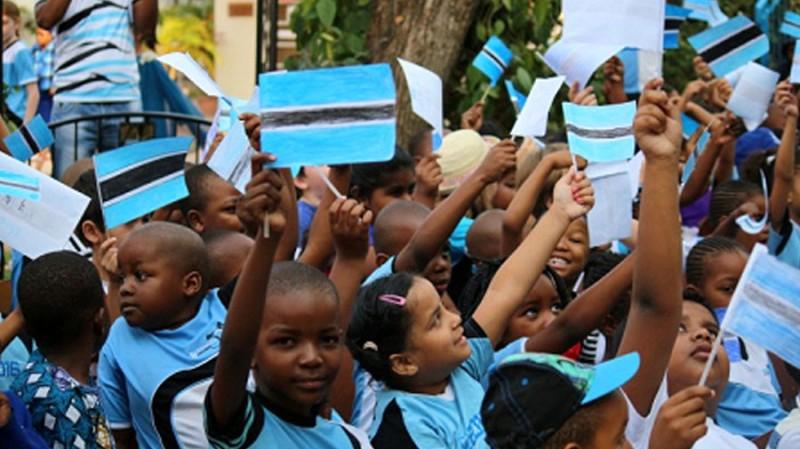
Botswana Independence Day - © The Diplomatist
What to Do in Gaborone
- Safari Tours at Mokolodi Nature Reserve: Take a safari tour at the nearby Mokolodi Nature Reserve, where you can see rhinos, giraffes, and a wide range of African wildlife. The reserve offers guided tours, allowing visitors to learn more about conservation efforts while enjoying close encounters with Botswana’s natural wonders.
- Kgale Hill Hiking: For those who enjoy outdoor activities, hiking Kgale Hill is a popular choice. The hill offers breathtaking views of the city and the surrounding landscape, and is a great way to experience Gaborone’s natural beauty.
- Historical Tours: Explore the Three Dikgosi Monument and take a guided tour of Gaborone’s historical landmarks to gain insights into Botswana’s journey to independence and the cultural significance of the Tswana people.
- Cultural Experiences: Engage with the local culture by visiting craft markets and art galleries in the city. Learn about Botswana’s traditional crafts and pick up souvenirs that reflect the artistry of the Tswana people.
Shopping in Gaborone
- Main Mall: The Main Mall is the heart of Gaborone’s shopping scene. It’s a pedestrian-friendly area filled with shops, restaurants, and street vendors. Fashion and gadgets can be found alongside traditional crafts. It’s a lively spot for both shopping and soaking up the local atmosphere.
- Craft Markets: For those interested in authentic local crafts, the Craft Markets in Gaborone are a treasure trove of handmade goods. Here, you can buy handcrafted jewelry, pottery, baskets, and textiles that reflect the rich cultural heritage of Botswana. These markets are also great places to interact with local artisans and learn about their craft.
- Riverwalk Mall: For a more modern shopping experience, visit the Riverwalk Mall, a popular destination for both locals and tourists. It offers a wide range of stores, from global brands to local boutiques, as well as cafes and restaurants, making it a convenient place for a full day of shopping and dining.

Safari Tours at Mokolodi Nature Reserve - © Mokolodi Nature Reserve Official
Weather in Gaborone: Best Time to Visit
Wet Season in Gaborone
- Weather: The wet season in Gaborone spans from November to March, characterized by higher temperatures and occasional rainfall. Daytime temperatures often reach up to 35°C (95°F), making it quite warm.
- Tourism Trend: This is a great time to visit if you enjoy lush landscapes and the sight of blooming vegetation. The rains are usually brief and occur in the form of afternoon thunderstorms, which provide a refreshing break from the heat. This season is also ideal for wildlife enthusiasts, as the cooler evenings attract various animal species to water sources, making for exciting game viewing opportunities in nearby reserves.
Dry Season in Gaborone
- Weather: The dry season, which runs from April to October, has colder temperatures and less rain. Daytime temperatures range from 20°C to 25°C (68°F to 77°F), with a bright and clear sky. Nights can be chilly, particularly from May to August, when temperatures may drop to around 5°C (41°F).
- Tourism Trend: This period is considered the best time for outdoor activities and exploring Gaborone’s attractions, as the pleasant weather is perfect for hiking, sightseeing, and enjoying outdoor events. The dry season also coincides with the peak tourist period, so it’s advisable to book accommodations and tours in advance.
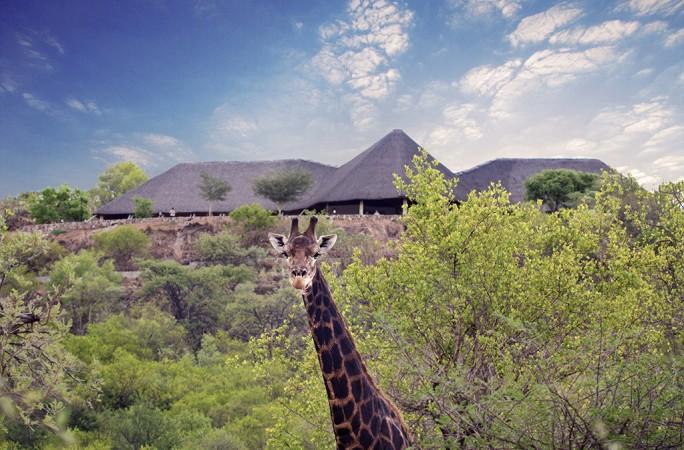
Capture the image of wildlife in Mokolodi Nature Reserve - © Mokolodi Nature Reserve Official
Observing Wildlife Etiquette in Gaborone
When exploring the wildlife around Gaborone, it’s essential to adhere to proper etiquette to ensure the safety of both visitors and animals, as well as to support conservation efforts.
- Respect Wildlife Distance: Maintain a respectful distance from wildlife to avoid disturbing their natural behavior and only observe them from a distance, use binoculars or your camera's lens. Approaching too close might agitate the animals and even cause defensive behaviors.
- Follow Park Rules: Always adhere to the rules and guidelines set by nature reserves and parks and avoid feeding animals, as this can alter their natural feeding habits and dependence on human-provided food.
- Stay on Designated Paths: Stick to marked trails and designated paths when exploring reserves and parks. This helps prevent damage to natural habitats and reduces the risk of encounters with potentially dangerous wildlife. Following these routes also minimizes the disturbance to animal territories.
- Respect Local Guidelines: If you’re participating in guided tours, follow the instructions given by your guide. They are knowledgeable about local wildlife and can offer valuable insights into best practices for observing animals while ensuring your safety.
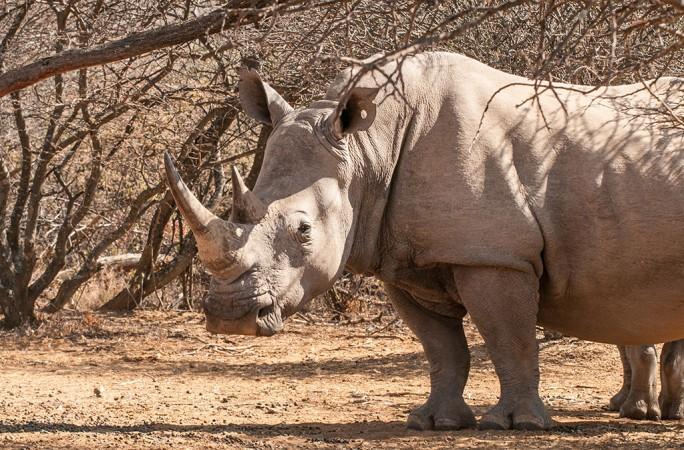
Observing wild animals in their natural habitats - © Mokolodi Nature Reserve Official
Essential Travel Information
Getting around Gaborone
- Taxis: Taxis are a popular mode of transport within the city. Private taxis and shared taxis (known locally as combis) are widely available. It’s important to negotiate the fare beforehand or confirm that the taxi is using a meter. For added convenience, some taxis now offer mobile app services, providing easier access for tourists.
- Car Rentals: For those looking for more freedom to explore at their own pace, car rentals are a great option. Gaborone has several international and local car rental agencies at the Sir Seretse Khama International Airport or in the city center. Driving in Gaborone is on the left-hand side of the road, and most major roads are in good condition.
- Public Buses: Although not as common for tourists, public buses and combis operate on set routes within the city and are the most affordable way to get around. They can be crowded, but they offer a glimpse into local daily life.
ATM & Banking Services
Gaborone offers modern banking facilities with numerous ATMs spread across the city, including at major shopping centers and commercial areas, making it easy for travelers to access cash. Most ATMs accept international debit and credit cards, though it's wise to notify your bank of your travel plans to avoid any issues. The local currency is the Botswana Pula (BWP), and while it's possible to exchange money at various banking institutions, many smaller vendors may prefer cash transactions.
Where to Stay in Gaborone
- Luxury Hotels: For those seeking a premium experience, luxury hotels in Gaborone provide upscale amenities such as swimming pools, fine dining options, and wellness facilities. These high-end properties offer exceptional service and convenience, making them ideal for travelers who prioritize comfort and elegance.
- Boutique Hotels & Guesthouses: If you prefer a more personalized stay, boutique hotels and guesthouses in Gaborone offer a cozy and intimate atmosphere. These accommodations combine comfort with local charm, providing a unique and memorable experience with attentive service and often, a touch of local culture.
- Budget Lodging: Gaborone has a variety of budget-friendly lodgings, including hostels and modest motels. These options provide essential amenities at affordable rates, making them suitable for budget-conscious travelers and backpackers.
Articles for you

Explore Yala National Park - Sri Lanka Travel, Asia
Tucked away in Sri Lanka’s southeastern corner, Yala National Park is where wild nature meets deep tradition. Known worldwide for its leopard population, the park is also home to elephants, sloth bears, crocodiles, and hundreds of bird species. Beyond wildlife, Yala opens doors to a cultural landscape dotted with ancient temples, Buddhist ruins, and coastal villages. For travelers seeking more than just a safari, Yala offers a chance to explore eco-tourism, local communities, and sacred heritage sites.
Population: The Yala National Park area doesn’t have a human population.
Economy: The economy around Yala National Park thrives on a blend of eco-tourism, agriculture, and local services. Safari tours, eco-lodges, and cultural experiences drive steady income for nearby towns like Tissamaharama and Kataragama, supporting thousands of families.
Landmarks: Famous for Block I of Yala and wildlife encounters, including elephants, sloth bears, crocodiles, and exotic bird species.

Explore Galle - Sri Lanka Travel, Asia
Nestled on Sri Lanka’s southern coastline, Galle is a vibrant city where history meets the sea. Its cobbled streets, colonial architecture, and serene beaches make it a must-visit destination for travelers seeking a blend of culture, adventure, and relaxation. A UNESCO World Heritage site, Galle captivates visitors with its Dutch Fort, bustling markets, and friendly locals. Whether you’re exploring the ramparts at sunset or savoring fresh seafood by the shore, Galle promises an unforgettable journey into Sri Lanka’s heritage.
Population: Approximately 113,000 in 2023.
Economy: Galle’s economy thrives on tourism, trade, and fisheries. The city’s historic fort, colonial architecture, and coastal charm draw thousands of international visitors each year, making tourism its main economic driver. Fishing remains vital for local livelihoods, supplying fresh seafood across the region.
Landmarks: Famous for the Galle Fort, Dutch Reformed Church & Maritime Museum, and Unawatuna Beach.

Explore Bentota - Sri Lanka Travel, Asia
Nestled along Sri Lanka’s southwestern coast, Bentota is a tropical paradise that blends golden beaches, vibrant culture, and thrilling adventures. Famous for its calm waters, luxury resorts, and scenic river estuary, Bentota has become a top destination for travelers seeking both relaxation and authentic experiences. From serene beach walks at sunrise to adrenaline-pumping water sports, this coastal town offers a perfect balance of leisure and exploration. With its proximity to Colombo and Galle, Bentota is easy to reach, making it an ideal stop for both short escapes and extended holidays.
Population: Approximately 37,000 in 2023.
Economy: Bentota’s economy thrives mainly on tourism, which drives local businesses such as hotels, restaurants, and wellness retreats. The town also benefits from fishing, coconut cultivation, and handicrafts like wood carving and batik textiles. Many residents rely on the growing demand for water sports and Ayurvedic treatments, making tourism the backbone of both income and employment in the area.
Landmarks: Famous for Bentota Beach, Bentota River Safari, and Kande Vihara Temple.

Explore Mirissa - Sri Lanka Travel, Asia
Mirissa is a charming coastal town on Sri Lanka’s southern shoreline. Known for its golden beaches, turquoise waters, and vibrant marine life, it has become a must-visit stop for travelers exploring the island. Many come for whale watching, surfing, and sunset views at Coconut Tree Hill, but Mirissa offers much more than postcard beauty. The fishing boats you see anchored by the bay carry generations of stories. Local traditions, delicious cuisine, and a laid-back rhythm of life shape every visitor’s experience.
Population: Approximately 4,700 in 2023.
Economy: Mirissa’s economy is largely shaped by its coastal location. Fishing has long been the backbone of local livelihoods, with generations relying on the Indian Ocean for income. In recent decades, tourism has become the main driver of growth, thanks to whale watching, surfing, and beachside hospitality.
Landmarks: Famous for Mirissa Beach, Coconut Tree Hill, and Parrot Rock Bridge.

Explore Nuwara Eliya - Sri Lanka Travel, Asia
Tucked away in the Central Highlands of Sri Lanka, Nuwara Eliya is often called “Little England”. With its rolling tea plantations, cool misty mornings, and colonial charm, this mountain town feels like a step into another world. Travelers come here to breathe fresh air, walk through flower gardens, sip the finest Ceylon Tea, and enjoy a pace of life far from the island’s busy cities. Whether you’re drawn by scenic landscapes, heritage architecture, or the warmth of its people, Nuwara Eliya is a destination that blends nature, culture, and history in perfect harmony.
Population: Approximately 781,000 in 2023.
Economy: Nuwara Eliya’s economy thrives mainly on tea production, as it sits in the heart of Sri Lanka’s central highlands, famous worldwide for Ceylon Tea. The city also benefits from a growing tourism industry, attracting visitors with its colonial charm, cool climate, and scenic landscapes.
Landmarks: Famous for Gregory Lake, Hakgala Botanical Garden, and Victoria Park.

Explore Sukau - Malaysia Travel, Asia
Nestled on the banks of the Kinabatangan River in Sabah, Malaysian Borneo, Sukau is a destination where wildlife, culture, and conservation come together. Known as one of Asia’s top spots for river safaris and eco-tourism, this quiet village offers a front-row seat to encounters with Bornean orangutans, pygmy elephants, proboscis monkeys, and exotic birdlife.
Population: Approximately 1,400 in 2019.
Economy: Sukau’s economy is shaped by its riverine location and natural resources. Traditionally, the Orang Sungai community relied on fishing, small-scale farming, and forest gathering for their livelihood. Today, the village has shifted toward eco-tourism, with river cruises, jungle trekking, and homestays providing income.
Landmarks: Famous for the Kinabatangan River cruises, Gomantong Caves, and Ox-bow lakes and wetlands.
